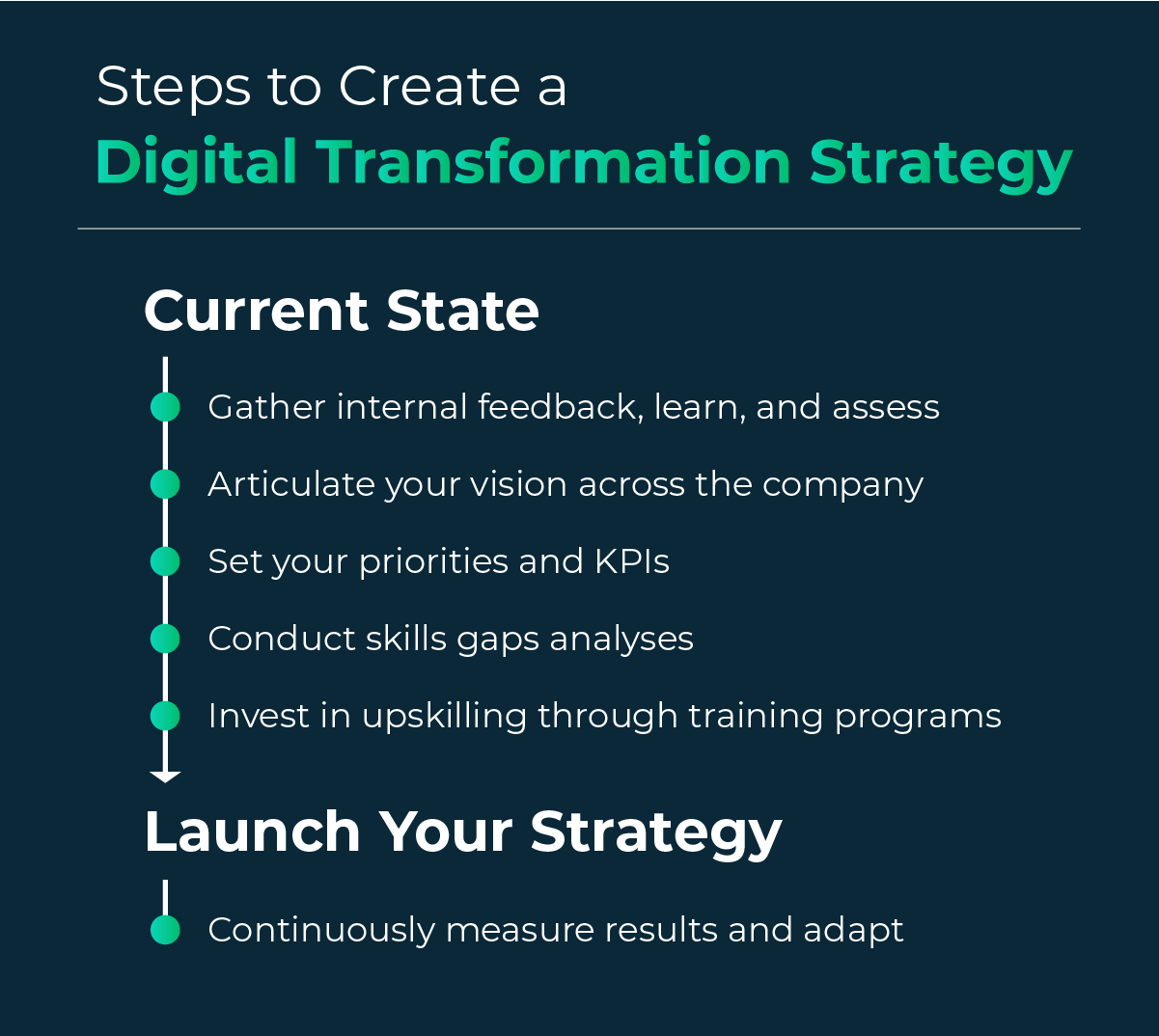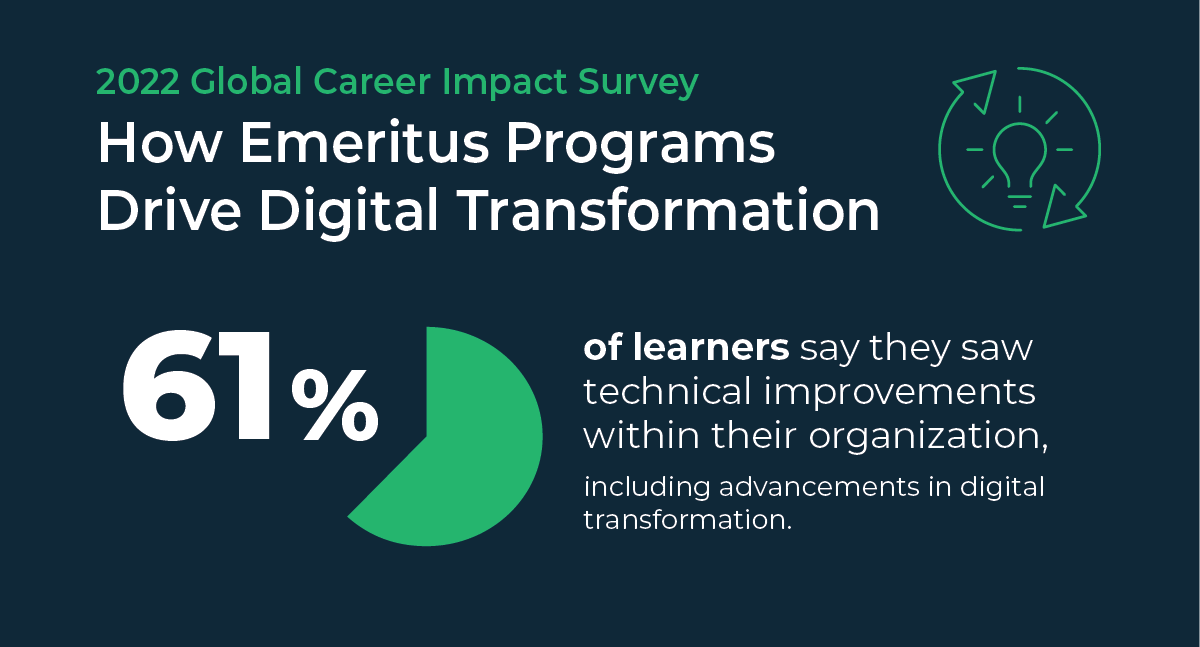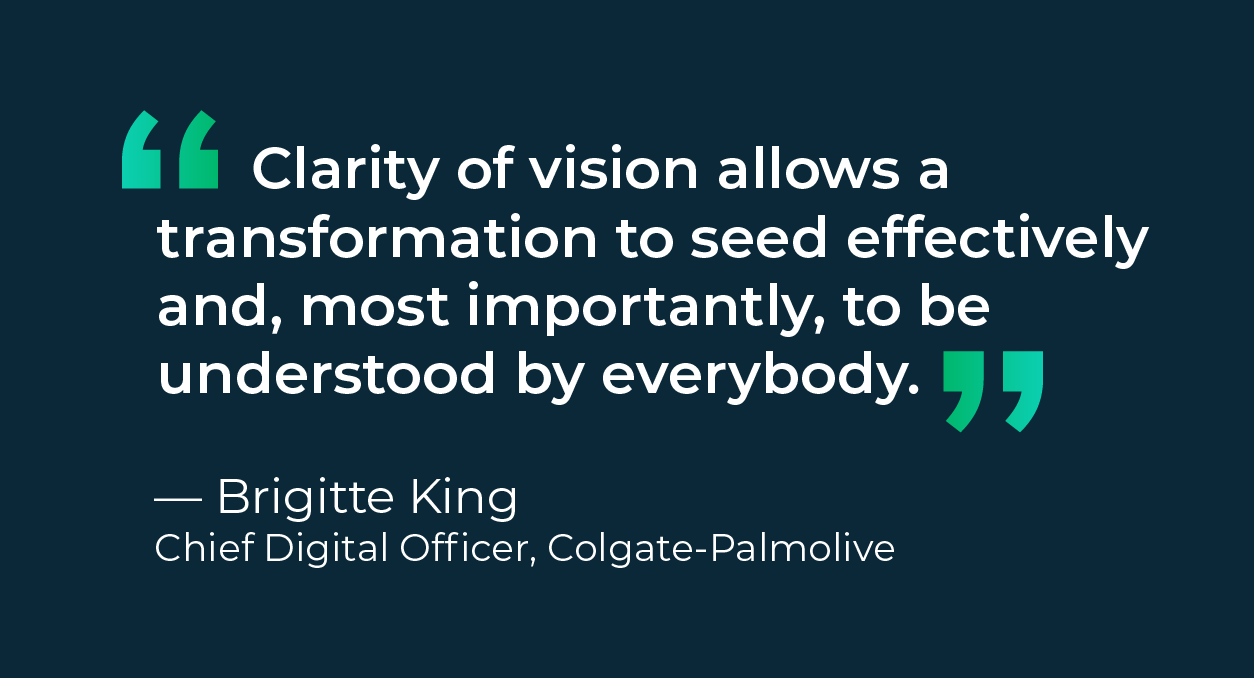How to Develop (and Launch) a Digital Transformation Strategy

For years, the pressure for organizations to adopt digital strategies has been building—and the COVID-19 pandemic only sped that transition. In today’s data-driven business environment, companies across industries face internal and external pressures to use emerging tools to streamline workflows, develop new products, and reach the market faster and more efficiently.
McKinsey & Company found that companies accelerated their adoption of digital approaches by several years during the pandemic, and the pace of change is not slowing.
But despite the pressure to adapt to new technologies, many companies are struggling to develop effective digital strategies. While 9 in 10 organizations said in a recent McKinsey survey that they undertook digital transformation efforts within the last two years, fewer than a third have seen the results they wanted.

In a recent conversation with Emeritus, Brigitte King, Chief Digital Officer at Colgate-Palmolive, shared tactical tips for developing and implementing a digital transformation strategy that works, as well as real-life digital transformation strategy examples from the organization of more than 30,000 employees.
What Is a Digital Transformation Strategy?
As you may know, the term digital transformation doesn’t just refer to adopting new tech tools. Instead, it typically describes the process of integrating technology throughout all levels of an organization. This results in changes to how a business operates internally and presents its products or services.
A true digital transformation strategy uses specific pieces of technology as tools while cultivating a company culture that grounds decisions in data and responds strategically to information about customer preferences and demand.
Successful digital transformation strategies allow companies to:
- Adapt nimbly to changing market conditions
- Refocus employees on high-value tasks
- Bring products and services to market more quickly
How to Create a Digital Transformation Strategy Roadmap
When done well, digital transformations offer numerous benefits—but investing time and resources upfront in planning for success is essential. At the Emeritus Enterprise event, King offered the following vital considerations for building a digital transformation strategy framework.

1. Listen, learn, and assess.
According to King, the first of several digital transformation stages is simply gathering information.
“One of the most important things you have to do in any transformation is to really listen hard to where people are,” King said. This means identifying their needs and where they are getting stuck.
Invest time upfront to gather feedback from across the organization on inefficient processes and misalignment between company offerings and customer needs. Gather preliminary information about skills employees and managers feel they need for success in a changing environment.
2. Clearly articulate your vision.
Before getting caught up in the weeds of digital transformation strategy creation, King recommends identifying your overarching goals and vision for the digital transformation.
“Sometimes, you need to go down to the proverbial one slide,” King said.
Your vision for the digital transformation is also essential for developing buy-in from both leadership and employees across the organization–and may require a culture change across your company.
“I think that clarity of vision allows a transformation to seed effectively and, most importantly, to be understood by everybody,” said King. Though the digital transformation strategy may shift over time, investing energy upfront pays dividends throughout the process.
3. Set priorities and KPIs.
Once those clear guiding principles have been established, leaders can map goals and KPIs for individual business units to those principles. Engaging with stakeholders across each unit is essential to ensure that priorities align with operational needs. And asking for input both builds positive engagement and can expose new opportunities.
According to McKinsey, digital transformations are 1.4 times more likely to succeed if employees can generate and share their own ideas about how digitization can help the business.
“You need to exercise two kinds of muscles: strategic intent and execution,” King said. At Colgate, she said, “We had senior leadership stakeholders, but we also had a lot of experts on the ground in our teams around the world at Colgate, and that made a world of difference.”
4. Identify skills gaps.
Any digital transformation strategy is only as good as the teams executing it—and if necessary skills are in short supply, you will likely run into trouble.
Once you have set your priorities, consider conducting a skills gap analysis to identify areas where the company needs to bolster its capabilities. These gaps may include technical skills relevant to new tools and processes as well as soft skills, like leadership and communication, which are necessary to manage and adapt to change.
“Transformations require both soft skills and hard skills in terms of change management to break down silos; get people to work differently together; get them to understand that their budgets, their individual objectives, and their priorities are actually codependent on each other,” King said. “That’s the part that I think is the most challenging for these transformations.”
5. Invest in upskilling.
You can close skills gaps by implementing either internal or external employee training programs—and for most organizations, upskilling is an essential part of that process. In addition to meeting specific skills needs, upskilling helps employees across the company become comfortable with using new tools and speaking the “language” of digital transformation.
At Colgate-Palmolive, King worked to create a comprehensive upskilling program designed to help thousands of employees embrace the company’s digital future. King’s team created several “tranches” of learning. They included digital fundamentals (available to the broadest group of employees), digital practitioner modules for employees who needed additional subject matter depth of knowledge, and targeted upskilling for senior leaders who did not have digital fluency.
6. Measure results and adapt accordingly.
To stay on track and ensure progress toward the digital transformation’s goals, it’s important to regularly check in with key stakeholders, watch progress against KPIs, and adapt when circumstances require it. As King noted, “With transformations, fail fast, fail forward. You have to be willing to try some new things. If they don’t work, pivot and move on.”
This is especially important when it comes to upskilling efforts. As King noted, every organization has early adopters who are enthusiastic about transformation and learning, passive learners, and resisters who lack the interest or the bandwidth to engage fully in transformation initiatives. Checking in regularly with learners and offering different types of content and engagement to meet these groups where they are can help smoothen the process.

Creating a digital transformation strategy can feel overwhelming at first, but breaking it down into manageable components, listening to stakeholders, and taking the time to prioritize effective communications all go a long way toward ensuring success.
Upskill to Launch Your Digital Transformation Strategy
Are you considering a digital transformation or preparing to embark upon one? Emeritus Academies offers a unique learning program designed to equip employees across all levels of the organization with the language and tools to drive success.
{
“@context”: “https://schema.org/”,
“@type”: “HowTo”,
“name”: “How to Develop (and Launch) a Digital Transformation Strategy”,
“image”: “https://s35764.pcdn.co/wp-content/uploads/2022/11/digital-transformation-strategy-roadmap-760×680.png”,
“step”: [
{
“@type”: “HowToStep”,
“text”: “According to King, the first of several digital transformation stages is simply gathering information. \n\n“One of the most important things you have to do in any transformation is to really listen hard to where people are,” King said. This means identifying their needs and where they are getting stuck.\n\nInvest time upfront to gather feedback from across the organization on inefficient processes and misalignment between company offerings and customer needs. Gather preliminary information about skills employees and managers feel they need for success in a changing environment.”,
“name”: “Listen, learn, and assess.”
},
{
“@type”: “HowToStep”,
“text”: “Before getting caught up in the weeds of digital transformation strategy creation, King recommends identifying your overarching goals and vision for the digital transformation.\n\n“Sometimes, you need to go down to the proverbial one slide,” King said.\n\nYour vision for the digital transformation is also essential for developing buy-in from both leadership and employees across the organization–and may require a culture change across your company. \n\n“I think that clarity of vision allows a transformation to seed effectively and, most importantly, to be understood by everybody,” said King. Though the digital transformation strategy may shift over time, investing energy upfront pays dividends throughout the process.”,
“image”: “https://s35764.pcdn.co/wp-content/uploads/2022/11/brigitte-quote-760×412.png”,
“name”: “Clearly articulate your vision.”
},
{
“@type”: “HowToStep”,
“text”: “Once those clear guiding principles have been established, leaders can map goals and KPIs for individual business units to those principles. Engaging with stakeholders across each unit is essential to ensure that priorities align with operational needs. And asking for input both builds positive engagement and can expose new opportunities. \n\nAccording to McKinsey, digital transformations are 1.4 times more likely to succeed if employees can generate and share their own ideas about how digitization can help the business. \n\n“You need to exercise two kinds of muscles: strategic intent and execution,” King said. At Colgate, she said, “We had senior leadership stakeholders, but we also had a lot of experts on the ground in our teams around the world at Colgate, and that made a world of difference.””,
“name”: “Set priorities and KPIs”
},
{
“@type”: “HowToStep”,
“text”: “Any digital transformation strategy is only as good as the teams executing it—and if necessary skills are in short supply, you will likely run into trouble. \n\nOnce you have set your priorities, consider conducting a skills gap analysis to identify areas where the company needs to bolster its capabilities. These gaps may include technical skills relevant to new tools and processes as well as soft skills, like leadership and communication, which are necessary to manage and adapt to change.\n\n“Transformations require both soft skills and hard skills in terms of change management to break down silos; get people to work differently together; get them to understand that their budgets, their individual objectives, and their priorities are actually codependent on each other,” King said. “That’s the part that I think is the most challenging for these transformations.””,
“name”: “Identify skills gaps.”
},
{
“@type”: “HowToStep”,
“text”: “You can close skills gaps by implementing either internal or external employee training programs—and for most organizations, upskilling is an essential part of that process. In addition to meeting specific skills needs, upskilling helps employees across the company become comfortable with using new tools and speaking the “language” of digital transformation. \n\nAt Colgate-Palmolive, King worked to create a comprehensive upskilling program designed to help more than 30,000 employees embrace the company’s digital future. King’s team created several “tranches” of learning. They included digital fundamentals (available to the broadest group of employees), digital practitioner modules for employees who needed additional depth of knowledge, and targeted upskilling for senior leaders who lacked digital experience.”,
“name”: “Invest in upskilling.”
},
{
“@type”: “HowToStep”,
“text”: “To stay on track and ensure progress toward the digital transformation’s goals, it’s important to regularly check in with key stakeholders, watch progress against KPIs, and adapt when circumstances require it. As King noted, “With transformations, fail fast, fail forward. You have to be willing to try some new things. If they don’t work, pivot and move on.” \n\nThis is especially important when it comes to upskilling efforts. As King noted, every organization has early adopters who are enthusiastic about transformation and learning, passive learners, and resisters who lack the interest or the bandwidth to engage fully in transformation initiatives. Checking in regularly with learners and offering different types of content and engagement to meet these groups where they are can help smoothen the process.\n\nCreating a digital transformation strategy can feel overwhelming at first, but breaking it down into manageable components, listening to stakeholders, and taking the time to prioritize effective communications all go a long way toward ensuring success.”,
“image”: “https://s35764.pcdn.co/wp-content/uploads/2022/11/DT-data-point-survey2-760×410.png”,
“name”: “Measure results and adapt accordingly.”
}
]
}






